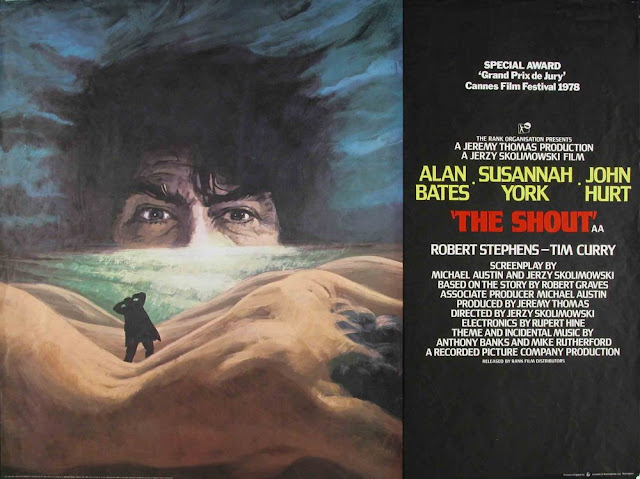The Shout (Jerzy Skolimowski, 1978)
Polish director Jerzy Skolimowski brought a unique, outsider’s eye to the portrayal of Britain on film. He brilliantly faked much of London in Deep End (1970) while characterising the same city as an incredibly paranoid, almost dystopian zone in Moonlighting (1982).
Most effective of all, however, is the director’s strange and darkly magical portrayal of the English coastline in his 1978 film The Shout, which contains – among many other unique things – one of British cinema’s most unnerving examples of sound design.
Based on a story by Robert Graves, and innovatively scored by Tony Banks and Mike Rutherford from the prog-rock band Genesis, Skolimowski’s film was always set to be an unusual artefact. But the director’s use of sound, with the help of sound editor stalwart Alan Bell, is where the film’s effectiveness resides, creating an eerie and overwhelming filmic experience.
The Shout is told in flashback, starting from a cricket match in an asylum where two inmates are telling how one of them came to be there. The story then follows a village couple, Rachel (Susannah York) and Anthony (John Hurt), who are visited by a stranger called Crossley (Alan Bates). With Anthony being an avant-garde musician, he becomes curious about Crossley’s supposed skills in aboriginal magic and the power to perform a shout that can kill. The film develops into a power play where magical elements are used to seduce Rachel and gradually remove Anthony from the scenario, psychologically and physically.
The film’s most powerful sequence concerns Crossley’s demonstration of his death shout for Anthony out on the coastline’s sand dunes. The scene builds with a long, walked journey to a place secluded enough to safely show the effects of the phenomena.
The dunes are a mythical landscape in themselves. Saunton Sands was also, in fact, where Peter (David Niven) from Powell & Pressburger’s A Matter of Life and Death (1946) was seemingly reincarnated. So there’s already something unusual in the air, and Skolimowski films the journey to nowhere with an abstract style. The pair then stop and prepare for the shout. Anthony covers his ears in haste, but Crossley stops him. He must only do so once the shout has begun.
Slow-motion images are subtly inserted throughout, making time in the sequence seem dreamlike and extended, to the point where the manic moment of the shout comes as a shock. Crossley’s towering body fills the frame from a low angle before the director quickly cuts in close to his screaming mouth, aping the paintings of Francis Bacon that are seen and mimicked throughout the film.
The shout is then released, the effect impossibly loud. There is a disjoint between the quietude of the build-up and the cut, jolting the viewer off guard for a brief moment before it is too late and they are immersed in the scream.
On first viewing, the moment creates a guttural feeling due to the mixing and editing. Skolimowski unusually cuts again, this time to the bodies of sheep and their shepherd falling into the sand. The linear progression of the film is as delicate as the memory and sanity of the perspective from which it is told.
For the rest of The Shout, Crossley gains an even more menacing air because of this scene. Knowing that at any moment he could open his mouth and allow that screaming thump of a wail to begin once more renders him dangerous to both the characters and the viewer.
Anthony stumbles down the dunes in shock at the power of Crossley’s voice and rightly so as Skolimowski shows the brutal power of the sound. But, with the effect so precise and perfectly pitched, the viewer cannot help but stumble down the sand with him, sharing in a brief moment of oblivion. --BFI











0 comments:
Post a Comment